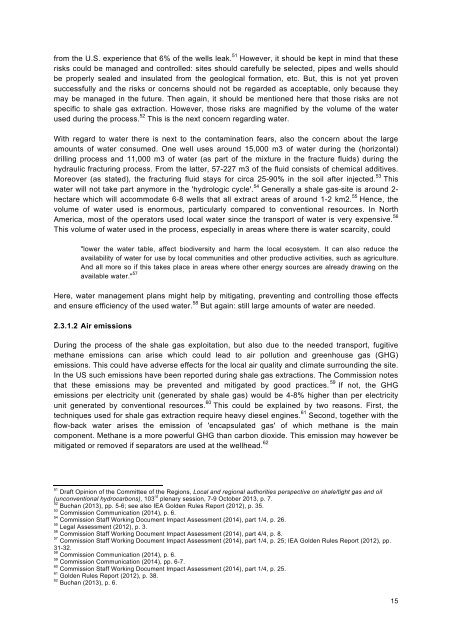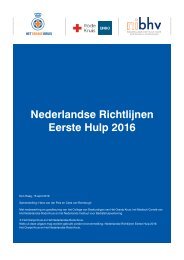Thesis-Anne-Vos-Masters-SBR-and-EU-Law-3
Thesis-Anne-Vos-Masters-SBR-and-EU-Law-3
Thesis-Anne-Vos-Masters-SBR-and-EU-Law-3
Create successful ePaper yourself
Turn your PDF publications into a flip-book with our unique Google optimized e-Paper software.
from the U.S. experience that 6% of the wells leak. 51 However, it should be kept in mind that these<br />
risks could be managed <strong>and</strong> controlled: sites should carefully be selected, pipes <strong>and</strong> wells should<br />
be properly sealed <strong>and</strong> insulated from the geological formation, etc. But, this is not yet proven<br />
successfully <strong>and</strong> the risks or concerns should not be regarded as acceptable, only because they<br />
may be managed in the future. Then again, it should be mentioned here that those risks are not<br />
specific to shale gas extraction. However, those risks are magnified by the volume of the water<br />
used during the process. 52 This is the next concern regarding water.<br />
With regard to water there is next to the contamination fears, also the concern about the large<br />
amounts of water consumed. One well uses around 15,000 m3 of water during the (horizontal)<br />
drilling process <strong>and</strong> 11,000 m3 of water (as part of the mixture in the fracture fluids) during the<br />
hydraulic fracturing process. From the latter, 57-227 m3 of the fluid consists of chemical additives.<br />
Moreover (as stated), the fracturing fluid stays for circa 25-90% in the soil after injected. 53 This<br />
water will not take part anymore in the 'hydrologic cycle'. 54 Generally a shale gas-site is around 2-<br />
hectare which will accommodate 6-8 wells that all extract areas of around 1-2 km2. 55 Hence, the<br />
volume of water used is enormous, particularly compared to conventional resources. In North<br />
America, most of the operators used local water since the transport of water is very expensive. 56<br />
This volume of water used in the process, especially in areas where there is water scarcity, could<br />
"lower the water table, affect biodiversity <strong>and</strong> harm the local ecosystem. It can also reduce the<br />
availability of water for use by local communities <strong>and</strong> other productive activities, such as agriculture.<br />
And all more so if this takes place in areas where other energy sources are already drawing on the<br />
available water." 57<br />
Here, water management plans might help by mitigating, preventing <strong>and</strong> controlling those effects<br />
<strong>and</strong> ensure efficiency of the used water. 58 But again: still large amounts of water are needed.<br />
2.3.1.2 Air emissions<br />
During the process of the shale gas exploitation, but also due to the needed transport, fugitive<br />
methane emissions can arise which could lead to air pollution <strong>and</strong> greenhouse gas (GHG)<br />
emissions. This could have adverse effects for the local air quality <strong>and</strong> climate surrounding the site.<br />
In the US such emissions have been reported during shale gas extractions. The Commission notes<br />
that these emissions may be prevented <strong>and</strong> mitigated by good practices. 59 If not, the GHG<br />
emissions per electricity unit (generated by shale gas) would be 4-8% higher than per electricity<br />
unit generated by conventional resources. 60 This could be explained by two reasons. First, the<br />
techniques used for shale gas extraction require heavy diesel engines. 61 Second, together with the<br />
flow-back water arises the emission of 'encapsulated gas' of which methane is the main<br />
component. Methane is a more powerful GHG than carbon dioxide. This emission may however be<br />
mitigated or removed if separators are used at the wellhead. 62<br />
51<br />
Draft Opinion of the Committee of the Regions, Local <strong>and</strong> regional authorities perspective on shale/tight gas <strong>and</strong> oil<br />
(unconventional hydrocarbons), 103 rd plenary session, 7-9 October 2013, p. 7.<br />
52<br />
Buchan (2013), pp. 5-6; see also IEA Golden Rules Report (2012), p. 35.<br />
53<br />
Commission Communication (2014), p. 6.<br />
54<br />
Commission Staff Working Document Impact Assessment (2014), part 1/4, p. 26.<br />
55<br />
Legal Assessment (2012), p. 3.<br />
56<br />
Commission Staff Working Document Impact Assessment (2014), part 4/4, p. 8.<br />
57<br />
Commission Staff Working Document Impact Assessment (2014), part 1/4, p. 25; IEA Golden Rules Report (2012), pp.<br />
31-32.<br />
58<br />
Commission Communication (2014), p. 6.<br />
59<br />
Commission Communication (2014), pp. 6-7.<br />
60<br />
Commission Staff Working Document Impact Assessment (2014), part 1/4, p. 25.<br />
61<br />
Golden Rules Report (2012), p. 38.<br />
62<br />
Buchan (2013), p. 6.<br />
15



